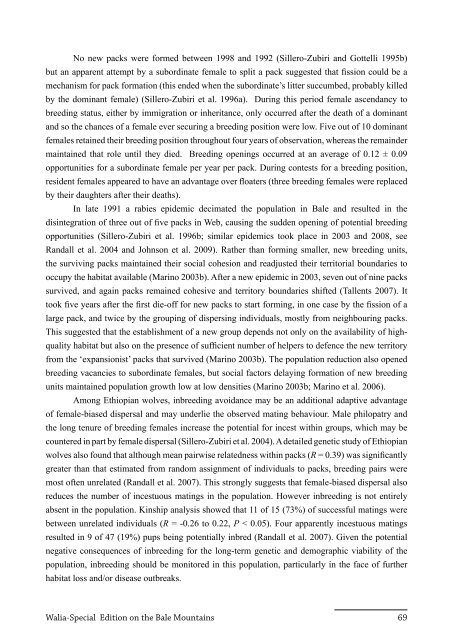Walia Special Edition on the Bale Mountains (2011) - Zoologische ...
Walia Special Edition on the Bale Mountains (2011) - Zoologische ...
Walia Special Edition on the Bale Mountains (2011) - Zoologische ...
You also want an ePaper? Increase the reach of your titles
YUMPU automatically turns print PDFs into web optimized ePapers that Google loves.
No new packs were formed between 1998 and 1992 (Sillero-Zubiri and Gottelli 1995b)<br />
but an apparent attempt by a subordinate female to split a pack suggested that fissi<strong>on</strong> could be a<br />
mechanism for pack formati<strong>on</strong> (this ended when <strong>the</strong> subordinate’s litter succumbed, probably killed<br />
by <strong>the</strong> dominant female) (Sillero-Zubiri et al. 1996a). During this period female ascendancy to<br />
breeding status, ei<strong>the</strong>r by immigrati<strong>on</strong> or inheritance, <strong>on</strong>ly occurred after <strong>the</strong> death of a dominant<br />
and so <strong>the</strong> chances of a female ever securing a breeding positi<strong>on</strong> were low. Five out of 10 dominant<br />
females retained <strong>the</strong>ir breeding positi<strong>on</strong> throughout four years of observati<strong>on</strong>, whereas <strong>the</strong> remainder<br />
maintained that role until <strong>the</strong>y died. Breeding openings occurred at an average of 0.12 ± 0.09<br />
opportunities for a subordinate female per year per pack. During c<strong>on</strong>tests for a breeding positi<strong>on</strong>,<br />
resident females appeared to have an advantage over floaters (three breeding females were replaced<br />
by <strong>the</strong>ir daughters after <strong>the</strong>ir deaths).<br />
In late 1991 a rabies epidemic decimated <strong>the</strong> populati<strong>on</strong> in <strong>Bale</strong> and resulted in <strong>the</strong><br />
disintegrati<strong>on</strong> of three out of five packs in Web, causing <strong>the</strong> sudden opening of potential breeding<br />
opportunities (Sillero-Zubiri et al. 1996b; similar epidemics took place in 2003 and 2008, see<br />
Randall et al. 2004 and Johns<strong>on</strong> et al. 2009). Ra<strong>the</strong>r than forming smaller, new breeding units,<br />
<strong>the</strong> surviving packs maintained <strong>the</strong>ir social cohesi<strong>on</strong> and readjusted <strong>the</strong>ir territorial boundaries to<br />
occupy <strong>the</strong> habitat available (Marino 2003b). After a new epidemic in 2003, seven out of nine packs<br />
survived, and again packs remained cohesive and territory boundaries shifted (Tallents 2007). It<br />
took five years after <strong>the</strong> first die-off for new packs to start forming, in <strong>on</strong>e case by <strong>the</strong> fissi<strong>on</strong> of a<br />
large pack, and twice by <strong>the</strong> grouping of dispersing individuals, mostly from neighbouring packs.<br />
This suggested that <strong>the</strong> establishment of a new group depends not <strong>on</strong>ly <strong>on</strong> <strong>the</strong> availability of highquality<br />
habitat but also <strong>on</strong> <strong>the</strong> presence of sufficient number of helpers to defence <strong>the</strong> new territory<br />
from <strong>the</strong> ‘expansi<strong>on</strong>ist’ packs that survived (Marino 2003b). The populati<strong>on</strong> reducti<strong>on</strong> also opened<br />
breeding vacancies to subordinate females, but social factors delaying formati<strong>on</strong> of new breeding<br />
units maintained populati<strong>on</strong> growth low at low densities (Marino 2003b; Marino et al. 2006).<br />
Am<strong>on</strong>g Ethiopian wolves, inbreeding avoidance may be an additi<strong>on</strong>al adaptive advantage<br />
of female-biased dispersal and may underlie <strong>the</strong> observed mating behaviour. Male philopatry and<br />
<strong>the</strong> l<strong>on</strong>g tenure of breeding females increase <strong>the</strong> potential for incest within groups, which may be<br />
countered in part by female dispersal (Sillero-Zubiri et al. 2004). A detailed genetic study of Ethiopian<br />
wolves also found that although mean pairwise relatedness within packs (R = 0.39) was significantly<br />
greater than that estimated from random assignment of individuals to packs, breeding pairs were<br />
most often unrelated (Randall et al. 2007). This str<strong>on</strong>gly suggests that female-biased dispersal also<br />
reduces <strong>the</strong> number of incestuous matings in <strong>the</strong> populati<strong>on</strong>. However inbreeding is not entirely<br />
absent in <strong>the</strong> populati<strong>on</strong>. Kinship analysis showed that 11 of 15 (73%) of successful matings were<br />
between unrelated individuals (R = -0.26 to 0.22, P < 0.05). Four apparently incestuous matings<br />
resulted in 9 of 47 (19%) pups being potentially inbred (Randall et al. 2007). Given <strong>the</strong> potential<br />
negative c<strong>on</strong>sequences of inbreeding for <strong>the</strong> l<strong>on</strong>g-term genetic and demographic viability of <strong>the</strong><br />
populati<strong>on</strong>, inbreeding should be m<strong>on</strong>itored in this populati<strong>on</strong>, particularly in <strong>the</strong> face of fur<strong>the</strong>r<br />
habitat loss and/or disease outbreaks.<br />
<str<strong>on</strong>g>Walia</str<strong>on</strong>g>-<str<strong>on</strong>g>Special</str<strong>on</strong>g> <str<strong>on</strong>g>Editi<strong>on</strong></str<strong>on</strong>g> <strong>on</strong> <strong>the</strong> <strong>Bale</strong> <strong>Mountains</strong> 69
















